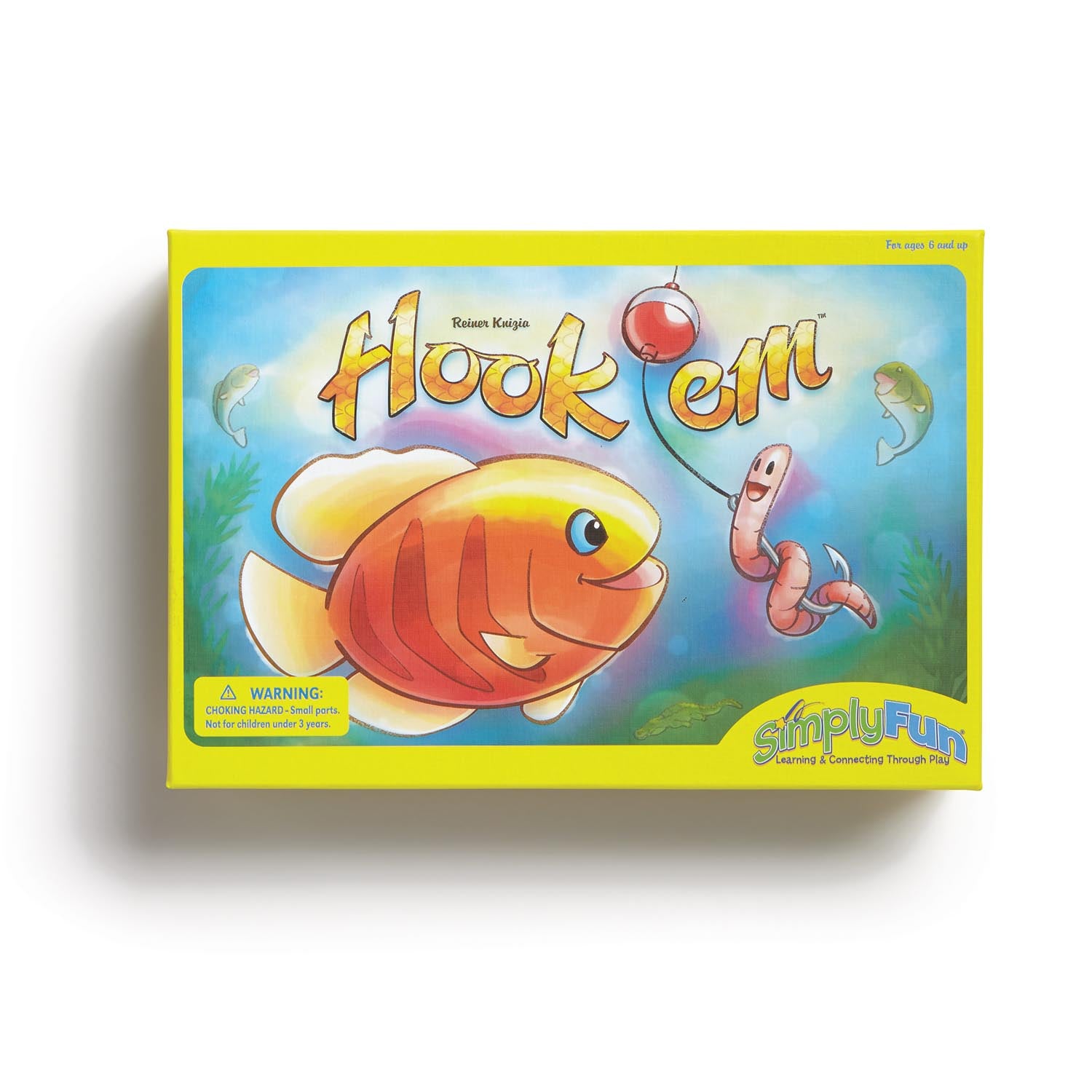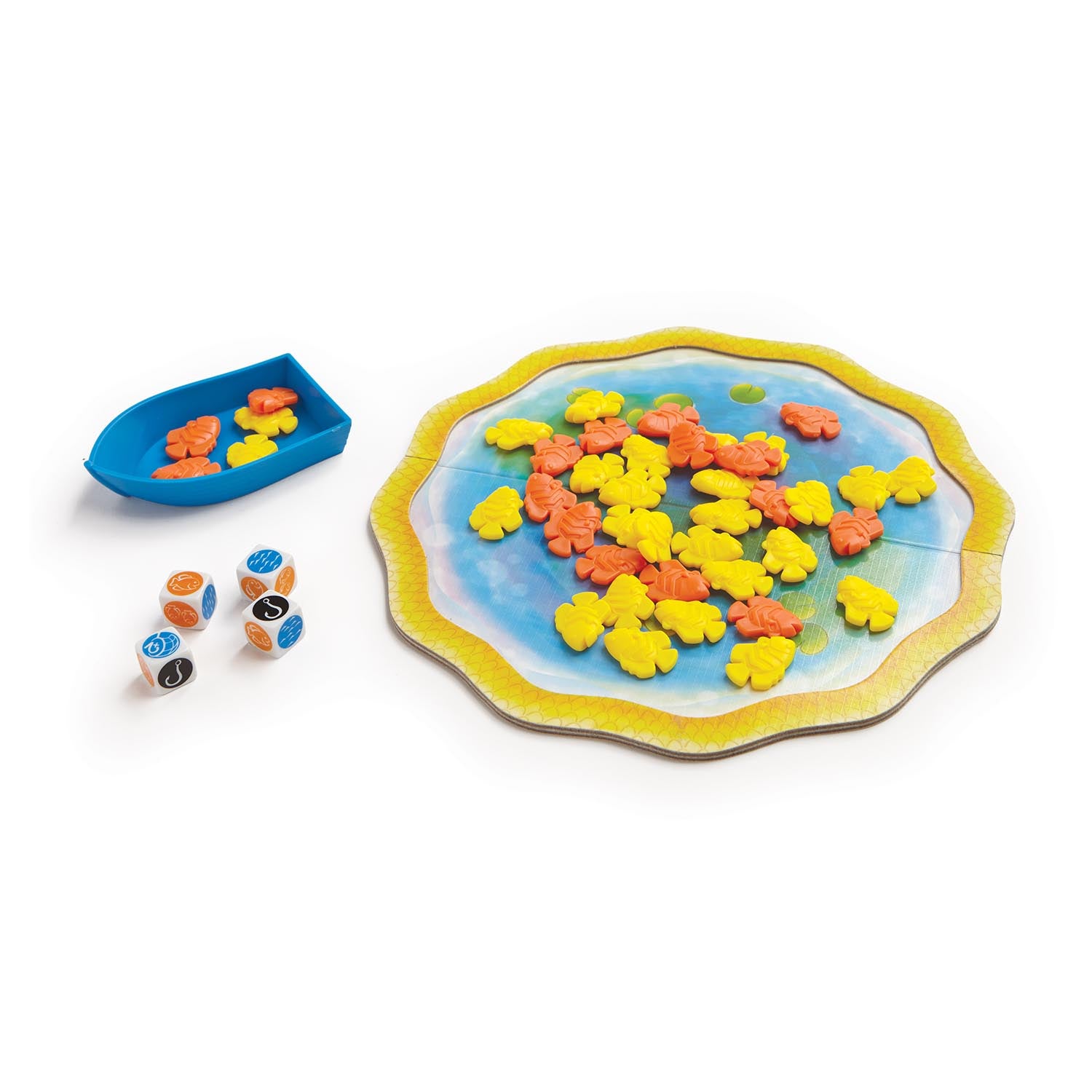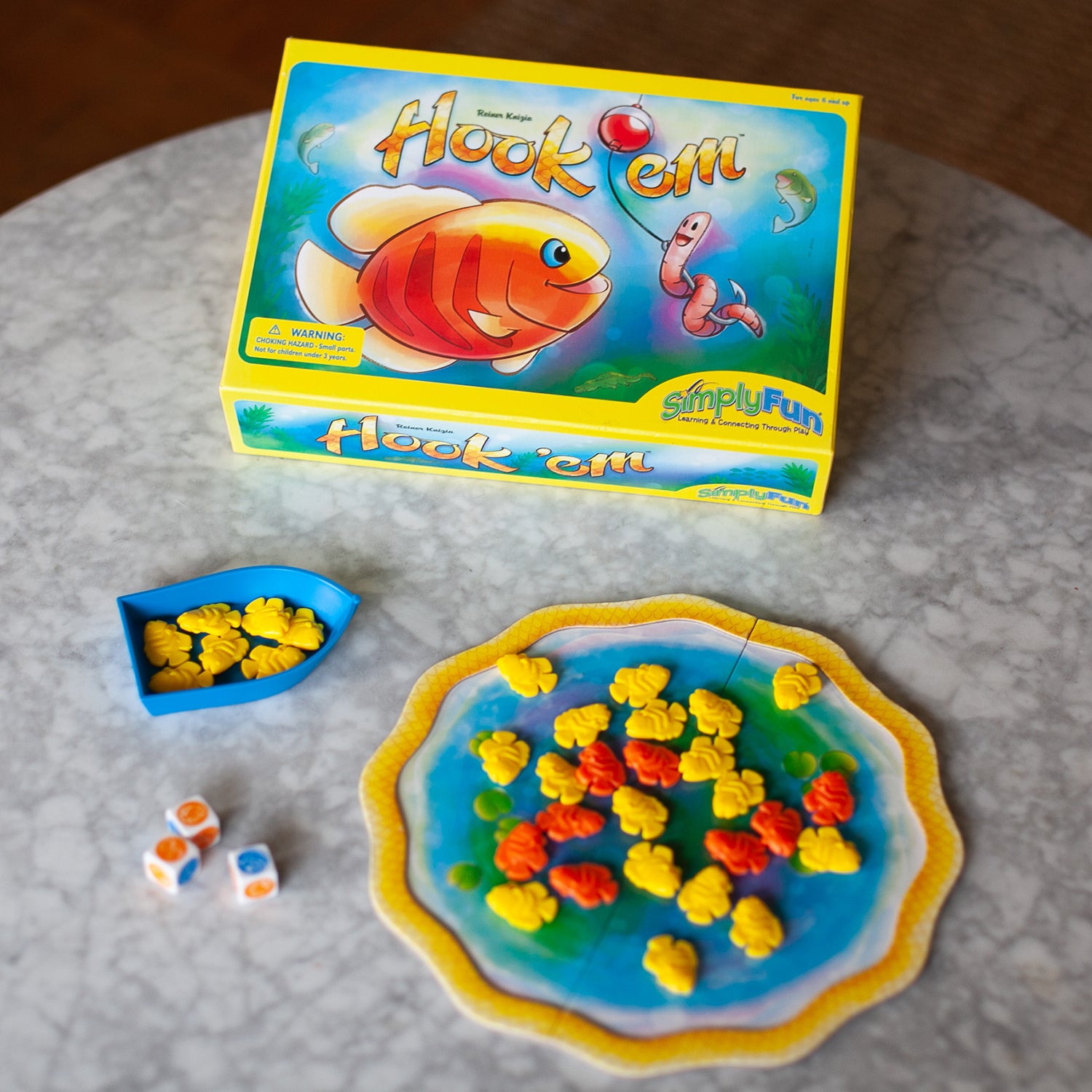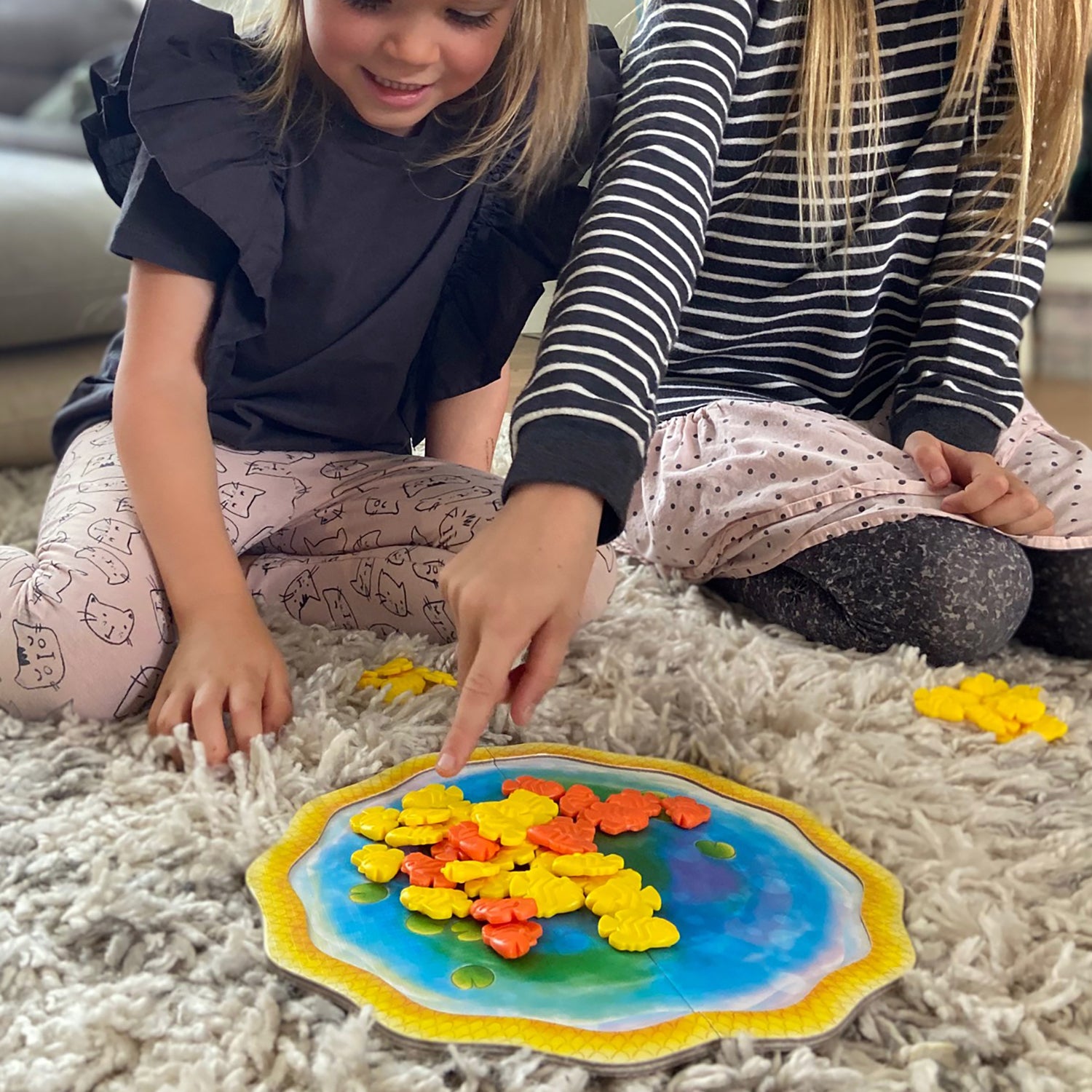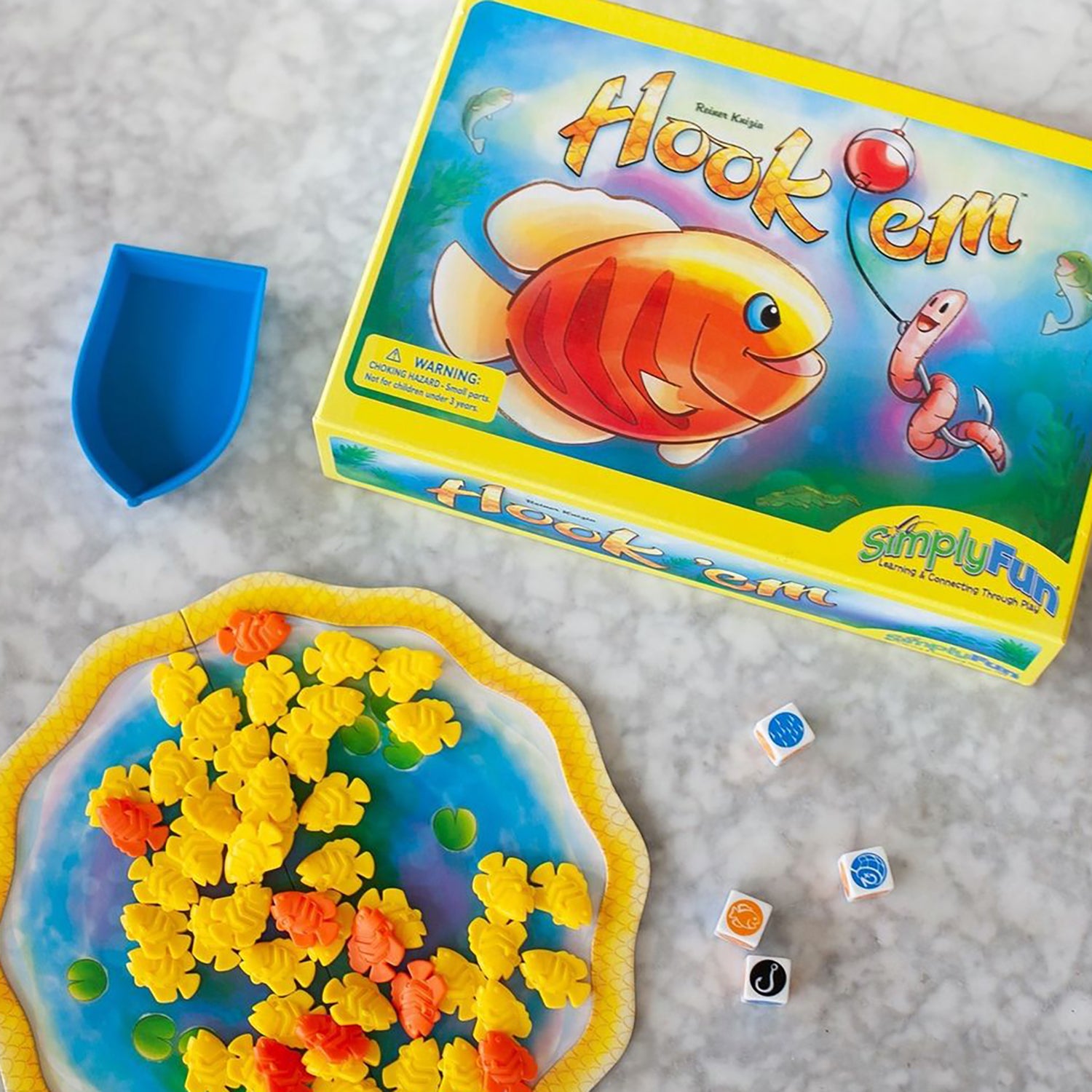Hook 'em
Hook 'em
2-8 players • 20 min • 6 & up
Focus: Counting
Couldn't load pickup availability
Roll the dice and collect your fish. Take a risk and roll again or bring your catch home. Develop decision-making skills with this risk-and-reward style game play.
Skills: Counting, Multiplication, Predicting
Game Includes
Game Includes
- 1 Pond Board
- 4 Dice
- 1 Fishing Boat
- 40 Yellow Fish
- 24 Orange Fish
- 1 Rules Booklet
Share
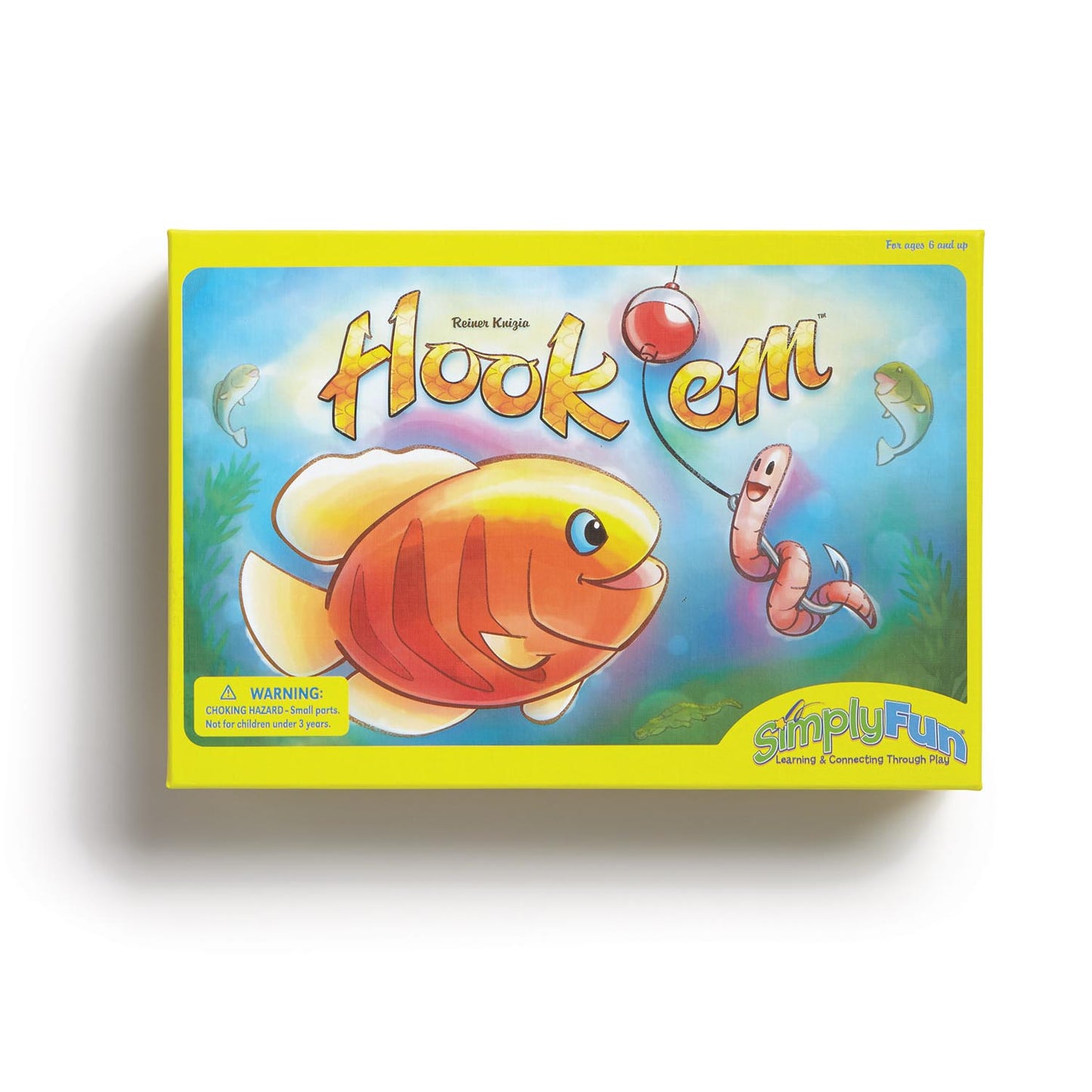
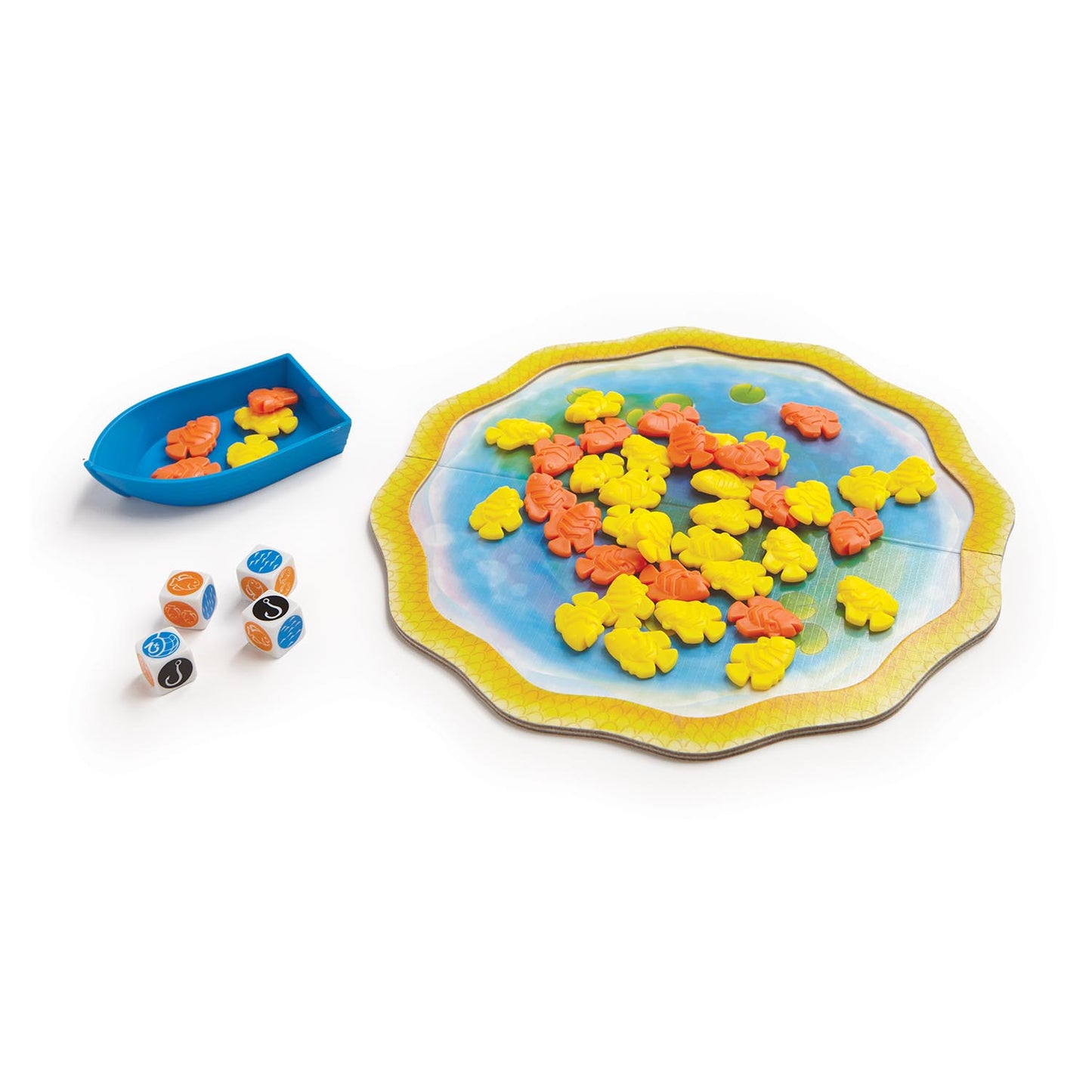
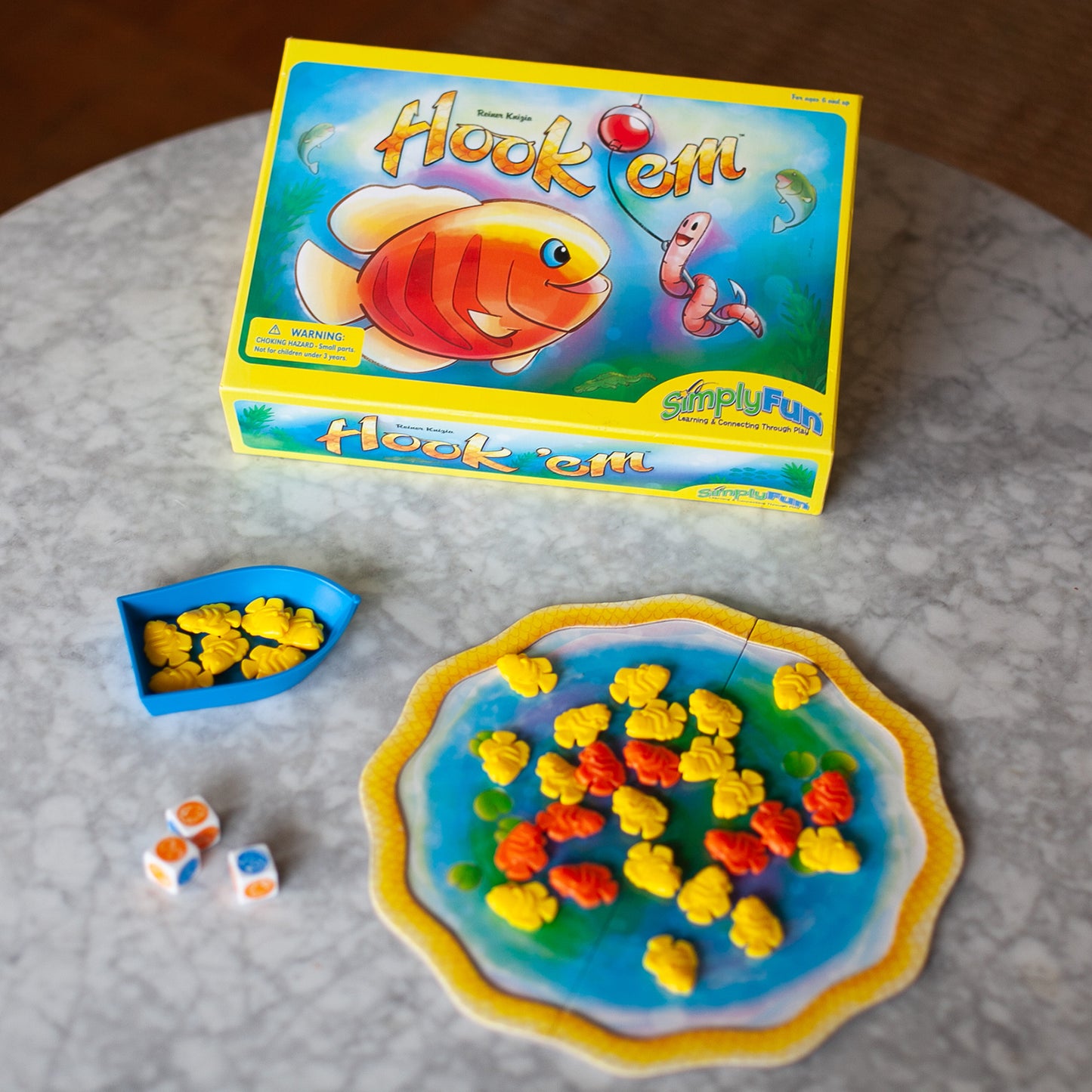
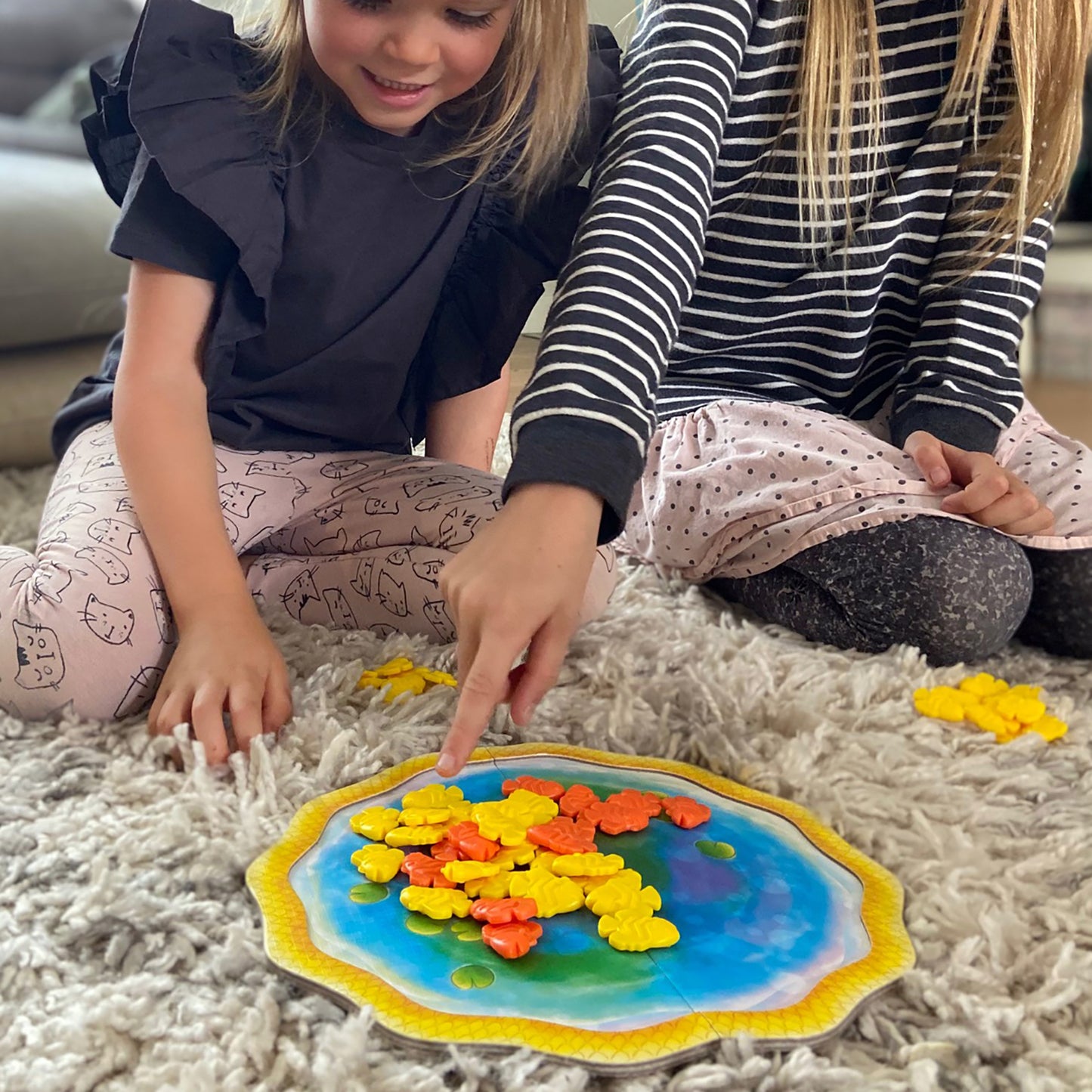
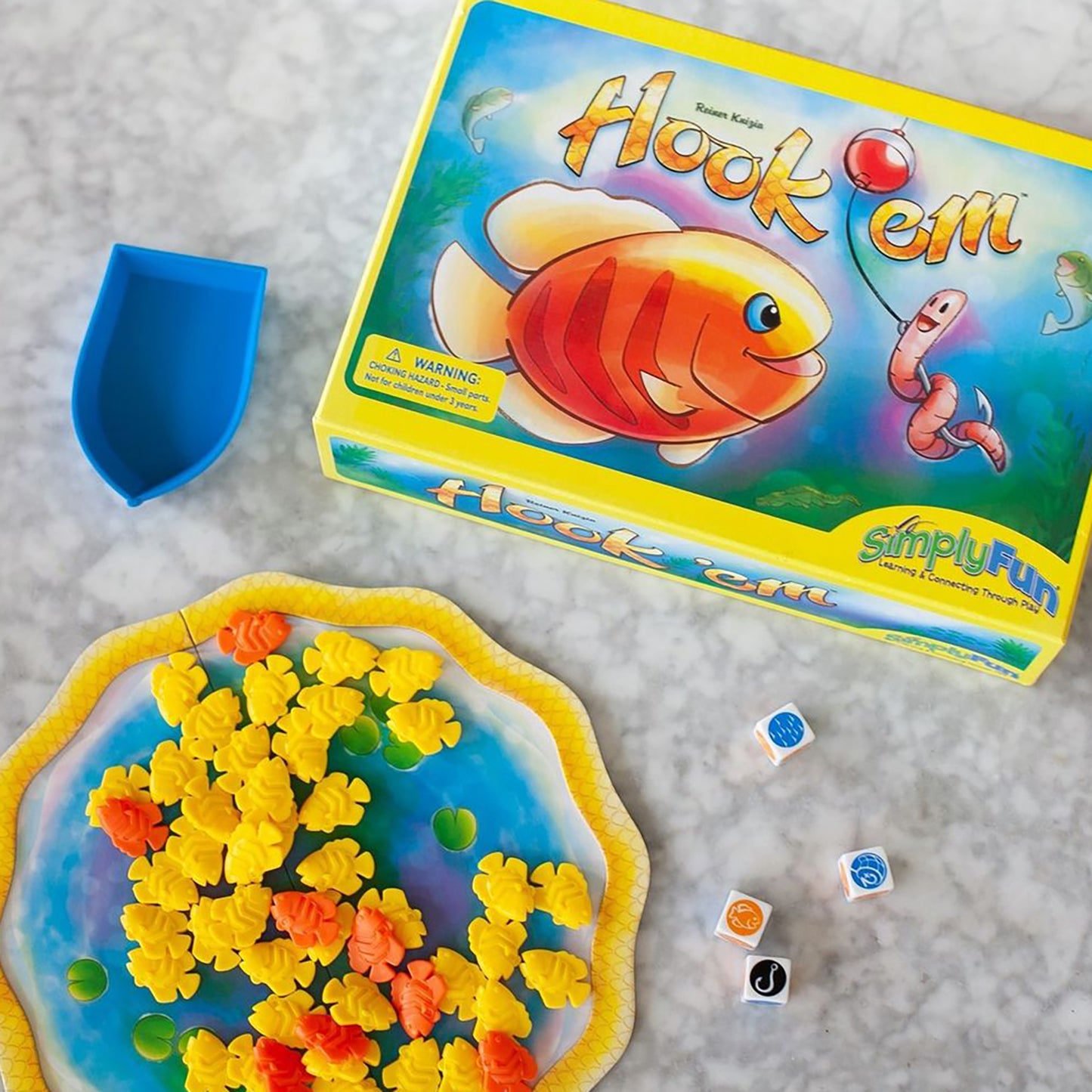


Collapsible content
How to Play
Educational Standards
Core Standard*: Math
Math
- Counting and Cardinality
- Know number names and the count sequence. Grade Level K
- Count to tell the number of objects. Grade Level K
- Operations and Algebraic Thinking
- Understand addition as putting together and adding to, and understand subtraction as taking apart and taking from. Grade Level K
- Add and subtract within 20. Grade Level 1st
- Represent and solve problems involving multiplication and division. Grade Level 3rd
- Mathematical Practice
- Attend to precision. Grade Level 1st, 2nd, 3rd
Skills
Explore
What Does Child Do To Use Skill In The Game?
Players look at the rolled dice to evaluate which dice may be scored, which to set aside for subsequent rolls and whether they may take fish from an opponent
How Parents Can Assist Learning
No special parent support required.
Learning Implications and Educator Support
No special adult support required.
Determine
What Does Child Do To Use Skill In The Game?
Players combine dice, including those set aside from prior rolls, to determine scoring, and whether to roll again. If the player rolls a hook and fish, they determine whether to take fish from pond or opponents. Additionally, players need to determine whether to roll again and to set aside any blue sided dice, in the event they decide to roll again.
How Parents Can Assist Learning
After rolling, encourage children to look at the dice that they set aside from prior rolls, if any. Those dice also are used in determining scoring. Also, to help children develop patience and precision, encourage them to look closely at the dice in order to ensure they are scoring properly.
Parents can also work with children on determining whether to take fish from opponents or from the pond when they roll a Hook. Ask the child to talk about the advantages or disadvantages of either option. Questions could include "How will another player react if you take his fish?" or "Is another player have more fish than you?"
Learning Implications and Educator Support
After rolling, encourage children to look at the dice that they set aside from prior rolls, if any. Those dice also are used in determining scoring. Also, to help children develop patience and precision, encourage them to look closely at the dice in order to ensure they are scoring properly.
Educators can also work with children on determining whether to take fish from opponents or from the pond when they roll a Hook. Ask the child to talk about the advantages or disadvantages of either option. Questions could include "How will another player react if you take his fish?" or "Is another player have more fish than you?"
Compare
What Does Child Do To Use Skill In The Game?
When players trade 5 yellow fish for 1 orange fish, they are comparing the different values assigned to each fish. Children also compare possible options in terms of potential benefit.
How Parents Can Assist Learning
No special adult support required for the trade. However, this type of comparison involves symbolic thinking, i.e. understanding relative values of smaller denominations and larger denominations. This type of understanding is foundational for learning about money (ex: five cents equals a nickel) and time (ex: 60 minutes equals an hour). Young children may be inclined to act impulsively. Encourage children to think about what might happen with another roll, whether to take fish from the board or another player, etc.
Learning Implications and Educator Support
No special adult support required for the trade. However, this type of comparison involves symbolic thinking, i.e. understanding relative values of smaller denominations and larger denominations. This type of understanding is foundational for learning about money (ex: five cents equals a nickel) and time (ex: 60 minutes equals an hour).Young children may be inclined to act impulsively. Encourage children to think about what might happen with another roll, whether to take fish from the board or another player, etc.
Remember
What Does Child Do To Use Skill In The Game?
Children need to remember the meaning of each die and how to use them. After playing numerous times, players will begin to remember prior decisions and outcomes. This will influence their ability to make more accurate risk-reward analysis on current rolls of the dice.
How Parents Can Assist Learning
If you see a child in a situation that is similar to a prior game, ask them what happened last time. In particular, when a child rolls a blue side up, they need to remove that die (dice) from the next roll. Remembering the consequences of the choices that were made in previous turns to improve strategic thinking going forward. Remind them of what happened on previous turns. This will help the child think more thoroughly and reduce impulsivity.
Learning Implications and Educator Support
If you see a child in a situation that is similar to a prior game, ask them what happened last time. In particular, when a child rolls a blue side up, they need to remove that die (dice) from the next roll. Remembering the consequences of the choices that were made in previous turns to improve strategic thinking going forward. Remind them of what happened on previous turns. This will help the child think more thoroughly and reduce impulsivity.
Predict
What Does Child Do To Use Skill In The Game?
Predicting is essential feature of Hook Em. After many rolls, a player has an option to roll again. This requires assessing the probability of rolling a successful or unsuccessful combination of dice. Also, players need to predict the reaction of another player if they take fish from that player. Young children will typically predict an outcome in their favor. Experience will make them more realistic.
How Parents Can Assist Learning
Playing Hook Em requires analyzing the odds of rolling scoring dice and whether the potential additional score is worth the risk of an unsuccessful roll (no fish are facing up). If a child rolls a hook and fish, there is additional risk-reward analysis in deciding whether to take fish from pond or opponent. All of this risk-reward analysis and choice-making is driven by making hypotheses and predictions, which is essential to strategic thinking.
Learning Implications and Educator Support
Playing Hook Em requires analyzing the odds of rolling scoring dice and whether the potential additional score is worth the risk of an unsuccessful roll (no fish are facing up). If a child rolls a hook and fish, there is additional risk-reward analysis in deciding whether to take fish from pond or opponent. All of this risk-reward analysis and choice-making is driven by making hypotheses and predictions, which is essential to strategic thinking.
Experiment
What Does Child Do To Use Skill In The Game?
Children may experiment with different strategies in the same or different games.
How Parents Can Assist Learning
No special parent support required.
Learning Implications and Educator Support
No special educator support required.
Practice
What Does Child Do To Use Skill In The Game?
Each turn for a player involves one or more throws and opportunities to practice strategy. The process of playing the game numerous times leads to better strategies for gaining more points or taking points from an opponent.
How Parents Can Assist Learning
There is no special adult support required. However, the more proficient children become in understanding the odds and assessing the reaction of other players, the more accurate their risk-reward analysis and choices will be.
Learning Implications and Educator Support
There is no special adult support required. However, the more proficient children become in understanding the odds and assessing the reaction of other players, the more accurate their risk-reward analysis and choices will be.
Solve
What Does Child Do To Use Skill In The Game?
Players win the game by having the most points (combination of yellow and orange fish) at the end of the game.
How Parents Can Assist Learning
Encourage children to try different strategies to solve, i.e. win, the game. For example, in one game suggest the child tries taking fish from opponents whenever s/he has the opportunity. In another game, avoid taking fish from opponents. Then, try a combination strategy. If more than one child is playing, have them all try the same strategy for a game. Discuss the results together to learn what works, does not work and why.
Learning Implications and Educator Support
Encourage children to try different strategies to solve, i.e. win, the game. For example, in one game suggest the child tries taking fish from opponents whenever they have the opportunity. In another game, avoid taking fish from opponents. Then, try a combination strategy. If more than one child is playing, have them all try the same strategy for a game. Discuss the results together to learn what works, does not work and why.
Review
What Does Child Do To Use Skill In The Game?
Children may voluntarily analyze their strategies during and after the game.
How Parents Can Assist Learning
If children do not spontaneously share their analysis, encourage them to discuss the results of different strategies. Adults can model this for them by sharing what happened as a result of their decisions about strategies.
Learning Implications and Educator Support
If children do not spontaneously share their analysis, encourage them to discuss the results of different strategies. Adults can model this for them by sharing what happened as a result of their decisions about strategies.
Demonstrate
What Does Child Do To Use Skill In The Game?
Players may demonstrate if encouraged. See How Parents Can Assist Learning.
How Parents Can Assist Learning
Encourage children to count all the fish aloud that they win on their turn.
Learning Implications and Educator Support
Encourage children to count all the fish aloud that they win on their turn. This will help develop one-to-one correspondence. Educators can also ask the children to count by 2s, 3s and so on to extend the numeracy and counting skills.
*Data compiled from CCSSI ELA Standards, WA Science Standards, and Washington Social Studies Standards
Special Needs
Cognitive
Suggestions for How to Modify Play Experience
To simplify the game and introduce some of the essential concepts, play as follows: For each turn, roll the dice. For any orange side facing up, take one fish from pond; for any blue side, set them aside; for any hook, take a fish from an opponent (if an opponent has a fish). Keep rolling until 4 blue sides have been rolled face up. Then pass turn to the left.
For children who do not yet understand multiplication, allow them to take 2 fish from the pond for each net rolled.
Communication
Suggestions for How to Modify Play Experience
Walk the child through the directions by demonstrating different options depending on what is rolled face up and which dice are already set aside. This will help children who have difficulty listening to directions and following them. Breaking up directions with a visual guidance supports memory. In addition, children may talk about their choices as they play. This is an opportunity for conversation about the various options, if available.
When playing Hook Em, have children do the math out loud. When they are deciding whether to roll again, have them discuss the advantages and disadvantages of re-rolling. What is the potential risk or reward? This encourages conversation and allows other players to contribute their ideas as well. If children play without discussing choices, ask questions to spark conversation. For example, "Whoa. I was lucky you didn't take fish from me. I have the most. I wonder what would have happened if you had taken my fish."
Encourage children to count one number at a time to total all the fish they catch on their turn. This helps develop counting skills. And, if all the fish are yellow, this helps children learn one-to-one correspondence, which is a critical foundational skill for higher level math.
Sensorimotor
Suggestions for How to Modify Play Experience
This game is good for fine motor practice. For an extra challenge, have children pick up the fish with their non-dominant hand, tweezers, or chopsticks.
If children have difficulty manipulating all of the dice, allow them to use a cup as a holder to shake and then tip upside down to throw.
Social Emotional/Behavioral
Suggestions for How to Modify Play Experience
When playing Hook Em, have children do the math out loud. When they are deciding whether to roll again, have them discuss the advantages and disadvantages of re-rolling. What is the potential risk or reward? This encourages conversation and allows other players to contribute their ideas as well. Pre-move discussion also encourages impulsive children to take their time to analyze options.
Have children play in teams of two. They can help each other with the mathematics and the strategic decisions regarding taking fish from another team or the pond. When children play in teams, they will practice negotiating, collaboration and turn taking.
Vision
Suggestions for How to Modify Play Experience
The images on the dice may be too difficult for children with low vision to distinguish.
Try using a magnifying glass, or create your own larger versions of the dice out of small cube-shaped boxes (such as used for individual Christmas balls). Another option is to add tactile cues to the dice (one felt dot for one fish, two felt dots for two fish, a felt hook for the fish hook, and a tic-tac-toe felt cut out for the net).
Hearing
Suggestions for How to Modify Play Experience
No special modifications required.
*Data compiled from CCSSI ELA Standards, WA Science Standards, and Washington Social Studies Standards
Autism
Autism Strengths & Interests
Short Summary of Strengths & Interests
- Likes games with tangible objects.
- Enjoys simple addition and multiplication problems.
- Can do risk/reward analysis.
Is good at matching visual items
This game is not appropriate
Has a good memory for sensory details, including visual, touch, taste and smell
This game is not appropriate
Has a good memory for words, phrases and dialouge
This game is not appropriate
Has a good memory for pictures, numbers and patterns
This game is not appropriate
Likes to put things in order or a sequence
This game is not appropriate
Learns through visualizing or "replaying" actions in their mind
This game is not appropriate
Likes activities with rules, such as math and phonics
Is This Game Appropriate? Yes
Description
Some children with autism are good at math and other activities that have clear rules to follow. Hook 'Em allows children to use this preference and skill on each turn. Players can add or multiply their fish depending on the symbols on the dice. Children also use rules such as one orange fish equals five yellow fish.
Is very concrete and literal
Is This Game Appropriate? Yes
Description
Hook 'Em is a very tactile game, which is good for children who like concrete, literal activities. For example, children may like the little boat, and they orange and yellow fish. These are concrete objects that are fun to manipulate. Dice are fun to roll. And, pictures on the dice provide directions for what each player should do.
Learns in small "chunks" (for example, phone numbers are 3 chunks of number xxx-xxx-xxxx that are combined together)
This game is not appropriate
Is good at nonverbal reasoning and logic
Is This Game Appropriate? Yes
Description
Hook 'Em involves non-verbal logic as children compare their catch to other players', and think about whether to continue to roll the dice for more fish or keep what they have and end their turn. However, they do not need to talk about their reasoning or strategy.
Likes spatial problem solving
This game is not appropriate
Can read well with good vocabulary, though may not fully comprehend content
This game is not appropriate
Likes to use and has good fine motor skill
Is This Game Appropriate? Yes
Description
On each turn, players sort through, count, and put the fish in the boat. This requires fine motor skills, but refined skills are not needed. Therefore, children who like playing with small objects like blocks, coins or actions figures will enjoy this feature of Hook 'Em.
Likes established routines or set ways of doing things
Likes manipulating, constructing or building things
Likes to use and has good musical abilities
This game is not appropriate
Likes to use and has good drawing skills
This game is not appropriate
Autism Special Considerations
Appears to ignore other's communication and/or has difficulty giving eye contact to a communication partner
Is This Game Appropriate for Child with Characteristic? Yes
Can Child with Characteristic Play Game w/o Modification? Yes
Strategies for Developing Compensatory Skills:
Look at the game instead of each other.
Rather than speak, sing communication between turns or when giving short directions. Music attracts the child's attention and interest.
Use unusual or exaggerated inflection to begin a communication about the game. This attracts the child's attention.
Has difficulty understanding complex verbal directions
Is This Game Appropriate for Child with Characteristic? Yes
Can Child with Characteristic Play Game w/o Modification? No
Strategies for Developing Compensatory Skills:
Break down directions into small steps. Don't go through all the directions at once.
Combine short verbal instructions with visual and physical examples of each step.
Check for comprehension by asking the child to show you what to do next. Also ask, what does this picture on the die mean.
For children who don't understand how to multiply and add small numbers, let children use counting manipulatives such as the fish) to determine how many fish they get.
Uses vocabulary inaccurately or demonstrates echolalia (repeating another's speech)
Is This Game Appropriate for Child with Characteristic? Yes
Can Child with Characteristic Play Game w/o Modification? Yes
Strategies for Developing Compensatory Skills:
Respond to immediate echolalia (repeating what was just said) by rephrasing the child's response into a correct format, so the child can hear and repeat that phrase. For example, assume you are playing with a child named Andy and you say, "Your turn," and Andy repeats, "Your turn." You can say, "It's Andy's turn. You say, my turn." This allows the child to hear and repeat the correct response. Eventually, the child will pick up the pattern of response.
Delayed echolalia (repetition of previously heard comments) may have a hidden meaning or association. Look for connection in the phrase used to the current situation. For example, the child says, "After these messages we'll be right back!" Think what the repeated phrase is associated with for the child. Try to interpret what is meant and rephrase it for the child. For example, you might respond by saying, "It sounds like you want a break for a few minutes. Is that what you mean? You can tell me, 'I need a break.'"
Gets stuck repeating a verbal topic or physical actions and/or has difficulty attending to others' actions or topic.
Is This Game Appropriate for Child with Characteristic? Yes
Can Child with Characteristic Play Game w/o Modification? No
Strategies for Developing Compensatory Skills:
Incorporate a preferred topic into the game to increase motivation. For example, if the child is fixated on a particular character, like a favorite super hero, ask what the character would do if they were playing?
Practice phrases for commenting on others' play actions. For example, you say to Joe (who is playing with you), "Right on! You got a total of 6 fish!." Then ask the child, "What did Joe do? Remind the child that it is nice to congratulate your friends when they do well.
Remind children about listening and watching others' before making their own comment or action.
Practice turn-taking in conversation. Use a cue, such as a touch on the shoulder, if needed.
Use a motivation toy or object to gain the child's attention. For example, a preferred wind-up toy can be placed on the board when it is the child's turn. The child gets to wind up the toy after completing their turn.
Use the child's finger to point to what needs attention. They will attend to their finger first, and then the adult can point out the object they are pointing at. For example, point to the picture of two fish, and say, "You only counted one fish. Look closer."
Extend the child's action to make a correct response. For example, if the child stops after the first roll, say, "Look at the dice. What can you do now?" Reinforce attention and actions by commenting on what was done correctly. For example, "Good for you. You remembered to remove the blue ones!"
Has difficulty producing speech/communication
Is This Game Appropriate for Child with Characteristic? Yes
Can Child with Characteristic Play Game w/o Modification? Yes
Strategies for Developing Compensatory Skills:
Use augmentative communication, such as picture cards. For example, a picture of person pointing to another person means "your turn."
Use gestures and sign language to illustrate actions or concepts. For example, hold up two fingers for two fish.
Extend the child's sounds into words or words into phrases to provide a model. For example, if the child says, "hook," the adult can say, " Hook means you can take a fish from someone."
Provide at least 10 seconds wait time for the child to process or produce responses. It may take longer to formulate a thought or response for children with special needs.
Has difficulty sequencing multi-step actions and/or doing complex abstract tasks
Is This Game Appropriate for Child with Characteristic? Yes
Can Child with Characteristic Play Game w/o Modification? No
Strategies for Developing Compensatory Skills:
Use physical actions to walk through steps numerous times, with less support for the final step each time. Practice reading the dice and talking about the meaning of the symbol until the child can do the actions associated with each die.
Supplement dice illustrations and pieces with additional visual cues. For example, make a picture to illustrate what each die means. The child can then refer to it if confused.
Demonstrates difficulty initiating and maintaining social interactions
Is This Game Appropriate for Child with Characteristic? Yes
Can Child with Characteristic Play Game w/o Modification? Yes
Strategies for Developing Compensatory Skills:
Develop a social story to be read at the start of a game. A social story is a short booklet that illustrates how a child can use positive social skills. It includes two to five descriptive statements and a directive statement. For example: "When I watch others, I will know when it is my turn. Others like me when I take turns. I will watch what others do with their pieces and listen to what they say. Others like it when I talk about the game." Add photos or drawings of the child doing the actions described in the story.
Role play social situations and reinforce appropriate words and actions. For example, role play finishing the game and congratulating the winner. Or, role play commenting on another player's turn. For instance, "Oh, too bad. They took your fish."
Use video feedback of positive social behaviors. Video of actual play enables children to see what they or others did. Appropriate actions and interactions can then be discussed.
Acts out or demonstrates avoidance behaviors when frustrated, overwhelmed, or needs more sensory input.
Is This Game Appropriate for Child with Characteristic? Yes
Can Child with Characteristic Play Game w/o Modification? No
Strategies for Developing Compensatory Skills:
Reduce extraneous noise or allow the child to wear head phones or ear plugs if loud sounds cause anxiety.
A weighted vest worn during the game may provide additional pressure input and thus reduce fidgeting due to sensory needs. Pressure can be calming when used for no more than 20 minutes at a time.
Practice a phrase to ask for help and role play situations in the game where it is needed.
Provide techniques for self-calming, such as holding a special toy.
Allow time for movement. For example, a child who needs to move frequently can be given an opportunity to 'celebrate' their turn by running around the table or jumping up and down 10 times.
Has short attention span for non-preferred activities
Is This Game Appropriate for Child with Characteristic? Yes
Can Child with Characteristic Play Game w/o Modification? No
Strategies for Developing Compensatory Skills:
Provide a break when needed.
Use "when...then" phrases. For example, "When you take your turn, then I'll let you play with your toy."
Frequently remind the child of the goal of the game. "You want the most fish."
Incorporate a motivating activity as part of the play. For example, each player gets to manipulate a fun 'fidget' toy, such as a stress ball or squeeze toy.
Needs sameness or consistent routines and/or has difficulty with transitions from one activity to another
Is This Game Appropriate for Child with Characteristic?
Can Child with Characteristic Play Game w/o Modification?
Strategies for Developing Compensatory Skills:
Play games at the same time every day, so the child anticipates the game routine.
Change the location of the game, so the child may play in different rooms, at the table, or on the floor. This will build tolerance for variation. Prepare the child ahead time for the introduction of a new game. Talk about aspects that will be motivating for the child, and let them explore the parts of the game before setting out the whole game.
Provide a structure for placement of game pieces that can be the same each time the game is played. For example, have a specific location for where the board goes, the pieces, etc.
Provide choices for how the child can be involved in set up or clean up. Involve the child verbally and with actions for the transition to the game table or at the end of game play. For example, you might say, "Let's look at the pictures on the game box and guess what it is about."
Use an object cue. Let the child hold an object from the game or activity you want to introduce prior to the transition. For example, if you were intending to play Hook 'Em you would hand the child a fish from the game and say, "Look here is a fish What game does it go with?"
Has difficulty understanding others' feelings, intentions, and the reasons for others' actions.
Is This Game Appropriate for Child with Characteristic?
Can Child with Characteristic Play Game w/o Modification?
Strategies for Developing Compensatory Skills:
Model and point out what others are feeling and comment on their facial expressions or words.
Discuss what causes feelings in others. For example, "You are happy because you got so many fish . But, look at Joe's face. He is not happy because you took his fish."
Ask child to explain their own feelings and intentions.
Ask child to explain why other players did specific actions in the game.
*Data compiled from CCSSI ELA Standards, WA Science Standards, and Washington Social Studies Standards
Extended Play
Extra Ways to Play the Game
To simplify the game and introduce some of the essential concepts, play as follows: For each turn, roll the dice. For any orange side facing up, take one fish from pond; for any blue side facing up, set them aside; for any hook, take a fish from an opponent (if an opponent has a fish). Keep rolling until 4 blue sides have been rolled face up. Then pass turn to the left. For children that have not learned multiplication, try having the net result in picking 2 extra fish from the pond.
Materials Needed
No additional materials required.
Developmental Benefits
This variation allows children to get accustomed to some novel rules of the game prior to incorporating more sophisticated math concepts.
Extra Ways to Play the Game
Add some scoring variations such as: if a player rolls 4 hooks, take 4 fish from the pond; or if a player rolls 4 waters, throw 4 fish back into the pond.
Materials Needed
No additional materials required.
Developmental Benefits
Variations create more surprises in the game. Surprises such as these, i.e. non-threatening or intense, help create additional motivation to play the game. This is called intrinsic motivation, which is more predictive of success later in life than IQ.
Extra Ways to Play the Game
For an extra challenge, have children pick up the fish with their non-dominant hand, tweezers or chopsticks. To go a little further, if a fish is dropped before placed in the boat, it must be returned to the pond.
Materials Needed
Tweezers, chopsticks or other tools for pick up objects.
Developmental Benefits
Adding a tool for picking up the fish will help children develop more complex fine motor skills. The skills are foundational for other skills such as eating or writing. Also, the rule that dropped fish are returned to the pond adds an element of risk to the game to increase challenge and excitement.
*Data compiled from CCSSI ELA Standards, WA Science Standards, and Washington Social Studies Standards
Collapsible content
How to Play Video & Transcript
Today, we’ll teach you to play Hook ‘em, Simply Fun’s game of luck and fishing, where fish are friends and nets are risky. One cast and you’ll be hooked!
You can play Hook ‘em with 2 to 8 players, ages 6 and up.
Each Hook ‘em game box comes with:
• one Pond board
• one fishing boat
• four dice
• forty Yellow Fish
• twenty-four Orange Fish
• one rule booklet
With Hook ‘em, kids get lots of math practice with early addition and multiplication. They also get introduced to risk assessment by deciding whether to roll the dice for more fish or call it a day and head home with the catch.
To set up the game, place the Pond board in the center of the table. Yellow fish are worth one point and orange fish are worth 5 points. Place all the yellow fish in the middle of the pond, then, add four orange fish to the pond for each player in the game. For example, if there are 2 players, put 8 orange fish in the pond. If there are 6 players, add 24. There ARE only 24 orange fish, so if you play with more than six players, just use all the orange fish.
The object of the game is to catch the most fish without losing your catch. Do you continue to cast your net and catch more fish, or stop casting and bring the catch home?
To begin, the first player receives the dice and the fishing boat and begins play by rolling the 4 dice.
Each die contains images of one or more fish, a net, a hook and water. For each fish represented on the dice, a player may take that number of YELLOW fish into the boat. A “net” is a multiplier if two – so if a player rolls one fish and one net, he may put 2 fish in the boat. If he rolls one fish and two nets, he may put 4 fish in the boat. A player might even roll two fish and three nets, resulting in a 16 fish catch! BUT be very careful: if a player rolls 4 nets, he loses his entire catch and passes the turn to the next player.
Since one orange fish is equal to five yellow fish, a player that rolls more than five fish may catch an orange fish in place of 5 yellow ones. Also, at any time, a player may simply exchange 5 yellow fish for one orange one, to keep more yellow fish in play.
A hook on the dice means a player may “catch” fish not only from the pond, but also from another player’s haul. Watch out for hooks if it’s not your turn!!
If the water image appears, no fish are caught but if the player decides to continue rolling, the water dice must be set aside.
Each turn consists of one or more rolls. A successful roll is one in which at least one fish appears among the dice. On subsequent rolls, players may only use dice on which a fish or a hook have appeared. Any “blue” dice images, with nets or water, must be set aside.
A player may continue to catch fish as long as at least one fish appears on the remaining dice. At any time, a player may choose to stop rolling and take home the catch, or risk his entire catch in hopes of a lucky roll. If his luck runs out, all the fish in the boat go back in the pond and play continues with the next player.
The game ends when one player takes the last fish from the pond. If there are not enough fish to match the roll, the player simply takes the remaining fish.
Players then count up their fish totals, one point for each yellow fish and five points for each orange fish, and the player with the highest total wins!
With Hook ‘em, you’ll create some great fishing success stories to share with your friends! Just hope you don’t have to tell about the one – or twenty – that got away!
- Choosing a selection results in a full page refresh.
- Opens in a new window.

